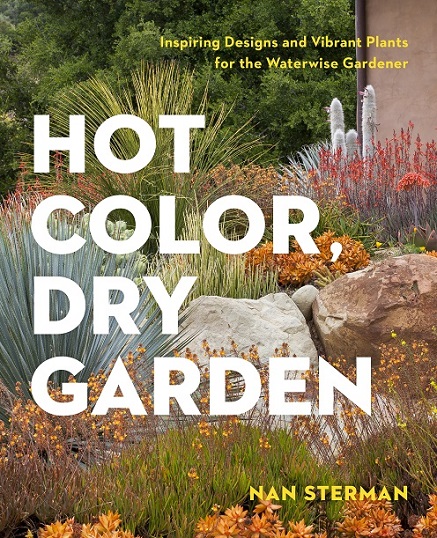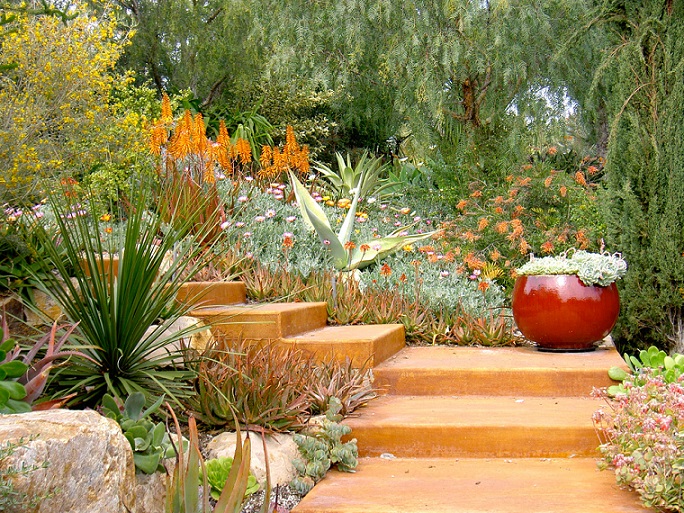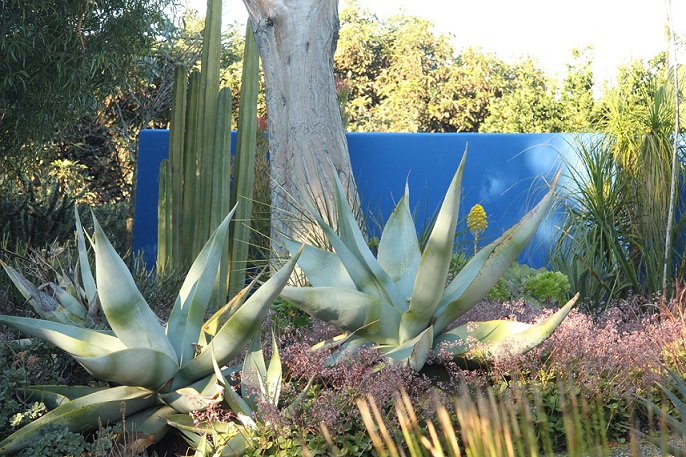Read This: Hot Color, Dry Garden can help you design your waterwise garden

Homeowners who want a waterwise garden, particularly if they live in the U.S. Southwest, often feel that their options are limited to cactus and gravel — a “zero-scape,” as it’s commonly called. If instead you’d like to have a true xeriscape (pronounced zeer-escape), a garden that doesn’t need tons of supplemental water to survive your region’s normal patterns of rainfall and heat, there are, happily, plenty of resources nowadays (including of course my own book The Water-Saving Garden).
One new book that can help you design the beautiful waterwise garden of your dreams is Nan Sterman‘s Hot Color, Dry Garden: Inspiring Designs and Vibrant Plants for the Waterwise Gardener. Written primarily for readers in California and the Desert Southwest, two regions with serious long-term water concerns, the book shows that you need not sacrifice color, excitement, and beauty as you create a garden that’s a responsible drinker.
In lieu of traditional but water-intensive flower borders and lawn, waterwise gardens tend to feature silver-green groundcovers, architectural succulents, and shrubs and perennials with small green or gray-green leaves. Aside from seasonal flowering, which can be particularly brilliant, or brightly hued succulents that thrive best in frost-free climates, color can be fleeting. Hence Sterman recommends incorporating colorful hardscaping — painted stucco walls, jewel-toned containers, vibrant furniture and pillows — as an all-season backdrop for the dry garden that helps make the plants visually pop. You’ll find inspiring examples in the “Garden Gallery” section, which features photos of 15 gardens from California, Arizona, and New Mexico, along with Sterman’s descriptive analysis of design elements in each garden.
An illustrated plant directory, succinct how-to chapter on dry gardening, and discussions of designing with color and texture round out the book. I’m a sucker for colored walls and architectural plants, so I especially enjoyed the garden gallery section, with its tours of lovely waterwise gardens. Sterman’s design advice for low-water gardens is also helpful, especially if you’re new to waterwise gardening. A caveat for my Texas readers (except West Texans): because of our sultrier climate, winter freezes, and higher rainfall, a lot of the plants featured here will not do well for us, so enjoy the book for the design inspiration and then translate appropriately with Texas-friendly plants.
Photos from the book courtesy of Nan Sterman.
Disclosure: Timber Press sent me a copy of Hot Color, Dry Garden for review. I reviewed it at my own discretion and without any compensation. This post, as with everything at Digging, is my own personal opinion.
I welcome your comments; please scroll to the end of this post to leave one. If you’re reading this in a subscription email, click here to visit Digging and find the comment box at the end of each post.
_______________________
Digging Deeper: News and Upcoming Events
Join the mailing list for Garden Spark Talks! Inspired by the idea of house concerts, I’m hosting a series of garden talks by inspiring designers and authors out of my home. Talks are limited-attendance events and generally sell out within just a few days, so join the Garden Spark email list for early notifications. Simply click this link and ask to be added.
All material © 2006-2018 by Pam Penick for Digging. Unauthorized reproduction prohibited.




I purchased this book a while ago but put it aside (for reasons I no longer recall) and had completely forgotten about it. Your post was a great reminder, sending me on a scavenger hunt that unearthed it in my bedside book pile. It’s just the ticket to lift me out of my summer garden doldrums and help me plan my fall planting. Thanks!
I find that gardening books help get me through the summer doldrums too. Reading about gardens instead of toiling in one in brutal heat? Yes!
Wow, that it a pretty gorgeous looking garden. And I love your phrase “responsible drinker.” I think we all need to be thinking that way in terms of our gardens these days.
For sure. Although I know your garden just got forced into drinking way more than it needed or wanted. Hope that kind of flooding doesn’t happen again anytime soon, Linda.
Love the colors in these hot, dry and self-sufficient gardens. We are in the Hill Country around Lake LBJ. Our eternal issue is the appropriate translation to Texas-friendly plants. Specifically, Yo Quiero un Translator! I want to go out into the outback of Texas-Friendly plants, way out past lantana, salvia, butterfly weed, etc. I want to go where the something different wow factor grows!!!
Jeff, thank you for your comment. I know just what you mean about longing for the “something different wow factor,” which especially rears its head when I see the Mediterranean-climate gardens of California and the more temperate gardens of the Pacific Northwest.
However, you gotta dance with the one that brung you, as they say. I think the answer is to use those tough, low-water Texas natives and mass the hell out of them for a big impact, and find striking contrasts of texture, form, and, if possible, color. So, for example, mass a dozen red yuccas and behind them plant a screen of ‘Blue Ice’ Arizona cypress. Or mass a curved line of Lindheimer muhly with possumhaw hollies behind them for those red berries in winter. You can see these sorts of big moves at the Wildflower Center in Austin to appreciate the impact of using more of what works here. And you can also perhaps find more-obscure natives to trial in your garden. If they work, plant LOTS.
And don’t overlook the color-by-hardscaping that Nan Sterman amply shows in her book. We Texans largely favor limestone walls, but the desert gardens farther west really get an impact from a painted stucco wall in the garden. See this example I photographed in Arizona: https://www.penick.net/digging/?p=26187
Although I live in an entirely different zone (NE Pa), I still find inspiration in books like these. And I love sharing the ideas with my son who lives in Arizona. I wish he would go beyond lantana and salvia. I guess I just found his birthday gift. P. x
Great idea, Pam. Maybe he’ll let you borrow it after he reads it. 🙂